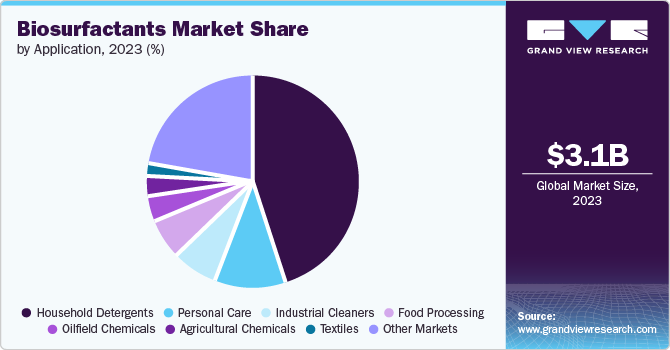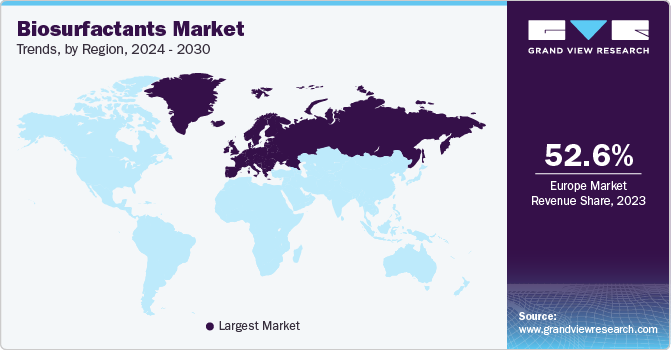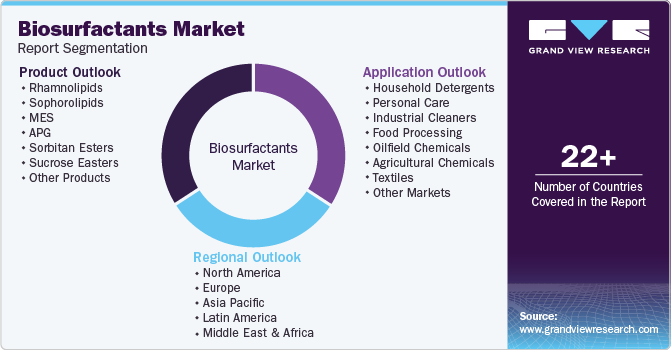
Biosurfactants Market Size, Share & Trends Analysis Report By Product (Rhamnolipids, Sophorolipids, MES, APG, Sorbitan Esters, Sucrose Esters), By Application (Household), By Region And Segment Forecasts, 2024 - 2030
- Report ID: 978-1-68038-012-5
- Number of Report Pages: 100
- Format: PDF
- Historical Range: 2018 - 2022
- Forecast Period: 2024 - 2030
- Industry: Specialty & Chemicals
Biosurfactants Market Size & Trends
The global biosurfactants market size was valued at USD 3.13 billion in 2023 and is projected to grow at a CAGR of 6.1% from 2024 to 2030. Growing consumer awareness, preference for sustainable and natural products, and increasing demand for cleaning and hygiene products are factors driving the biosurfactants market.

The biosurfactants industry is experiencing a surge in demand due to the increasing awareness of the environmental benefits of biodegradable and renewable raw materials. Biosurfactants, produced by yeast, fungi, and bacteria, offer a more sustainable alternative to synthetic surfactants, with advantages such as low toxicity and easy biodegradability. As a result, the market for biosurfactants is expanding across various industries, including food processing, personal care products, medicines, and agriculture.
The growth of the biosurfactants market is attributed to its eco-friendly properties, which set it apart from synthetic surfactants. The production of biosurfactants is gaining popularity among manufacturers, who are shifting towards environmentally friendly products to meet consumer demands. Furthermore, government support and consumer awareness about the benefits of biosurfactants are expected to continue to drive the market growth.
The applications of biosurfactants are diverse, encompassing fields such as food and beverages, pharmaceuticals, agriculture, cosmetics, and oil recovery. The increasing adoption of biosurfactants as substitutes for chemical surfactants is also contributing to the market growth. Factors such as heightened awareness about environmental impact and cost advantages of biosurfactants is likely to further propel the market growth. As consumers become more aware of the benefits of eco-friendly products, the demand for biosurfactants is expected to increase, leading to a substantial growth in the global biosurfactants market in the coming years.
Product Insights
MES accounted for the largest market revenue share of 33.4%% in 2023. MES, derived from renewable resources such as palm and coconut oil, is a cost-effective and eco-friendly alternative to synthetic surfactants. It’s biodegradable, non-toxic, and exhibits excellent detergency, foaming, and wetting abilities, making it suitable for various cleaning applications in laundry soaps, dishwashing soaps, and household products.
Rhamnolipids is expected to register the fastest CAGR of 10.9% during the forecast period.Rhamnolipid biosurfactants are gaining global attention due to their unique features and environmental benefits. These surfactants have been found to reduce surface tension, emulsify, wet, and foam, making them versatile for various applications. Synthesized by bacteria such as Pseudomonas aeruginosa, rhamnolipids are being increasingly adopted in industries as the world shifts towards more eco-friendly products.
Application Insights
Household detergents dominated the market and accounted for a share of 45.0% in 2023. Biosurfactants, produced by microorganisms, are gaining attention as eco-friendly ingredients in household products. They can be used in dishwashing liquids, laundry detergents, and cleaning agents, effectively removing dirt, grease, and stains. Compared to traditional chemicals, biosurfactants are less toxic and environment-friendly, making them a safer choice for homes with children and pets.

Personal care is projected to grow at the fastest CAGR of 6.3% over the forecast period. Biosurfactants are widely used in shampoo and body wash production due to high demand for natural and gentle cosmetics. Their inclusion allows products to be labeled as natural and environment-friendly, justifying higher prices. As consumer awareness increases, the demand for natural products grows, presenting a promising market opportunity for biosurfactants in the personal care segment.
Regional Insights
North America biosurfactants market was identified as a lucrative region in 2023. The changes in consumer choices are expected as a result of increasing worry over the harmful effects of toxins released by chemical surfactants during decomposition. The market is expected to expand due to increasing expenditure on health and cleanliness. In addition, increasing need for biosurfactants in the petroleum & oil sector for enhancing oil recovery is anticipated to drive expansion.
U.S. Biosurfactants Market Trends
The biosurfactants market in the U.S. is expected to grow rapidly in the coming years due to a growing demand for natural and organic products across all sectors. This includes personal care products, detergents, and even food items. Biosurfactants are considered perfect for this purpose, as they are derived from renewable resources.
Europe Biosurfactants Market Trends
Europe dominated the global biosurfactants market with a share of 52.6% in 2023. Increasing knowledge among manufacturers concerning the utilization of EA to reduce CFPs should drive the market forward. Higher legislation regarding the consumption of certain chemicals that may yield dangerous by-products or toxins when afflicted with biological decomposition is also anticipated to drive better growth. In regard to the Europe legislation, based on the information provided by the European Commission, the Europe community introduced a policy to reduce surfactant content in detergents from 1970 to prevent the foaming in water systems that affects the marine environment.

The biosurfactants market in the UK dominated the Europe market in 2023. The personal care and cosmetics market in the UK to meet the demand for natural raw materials. The utilization of biosurfactants is a means towards creation of efficient, environment-friendly products. The law on obtaining or disposing of hazardous substances is very strict in the UK, which encourages the industries to use the biosurfactants to replace those synthetic surfactants, which may not be compatible with new environmental measures.
Asia Pacific Biosurfactants Market Trends
Asia Pacific biosurfactants market is anticipated to witness significant growth in the market. The growing concern of the public about the impact of the regular surfactants on the environment and people’s heath also favor the use of biosurfactants in the region. China, Japan, India, South Korea are the principal countries driving the Asia Pacific biosurfactants market. Hence, it can be concluded that the increasing usage of personal care and home care products along with the implementation of environmental friendly technologies used are some of the factors that may further fuel the growth of the market in the coming years.
The biosurfactants market in China is expected to grow rapidly over the forecast period due to China’s booming industries, particularly those in food processing, textiles, and oil and gas, are creating a strong demand for high-performance cleaning agents. Biosurfactants offer a viable solution due to their effectiveness and biodegradability.
Key Biosurfactants Company Insights
Some key companies in biosurfactants market include Evonik Industries AG; Allied Carbon Solutions Co., Ltd.; Saraya Co., Ltd.; and Jeneil Biotech, Inc. Fueled by the growing demand for eco-friendly products across industries, key players form strategic partnerships to gain a competitive edge and boost market share in the biosurfactants market.
-
Evonik Industries AG, a subsidiary of RAG-Stiftung, offers a wide range of products, including surfactants, polymers, resins, and additives. Its products are utilized in various industries such as agriculture, renewable energy, paints, coatings, paper, and others.
-
Jeneil Biotech is a producer of biosurfactants, with over 50 years of experience in flavor technologies. The company develops dairy and plant-based flavors, probiotic cultures, and flavor chemicals through fermentation and enzyme technology. Its rhamnolipid biosurfactants are manufactured using renewable resources and precision fermentation, offering environmentally friendly and sustainable solutions.
Key Biosurfactants Companies:
The following are the leading companies in the biosurfactants market. These companies collectively hold the largest market share and dictate industry trends.
- Evonik Industries AG
- Allied Carbon Solutions Co., Ltd.
- Saraya Co., Ltd.
- Jeneil Biotech, Inc.
- Solvay S.A.
- Givaudan
- Synthezyme LLC
- Kaneka Corporation
- GlycoSurf LLC
- Stepan Company
Recent Developments
-
In May 2024, Evonik Industries AG inaugurated a new facility in Slovakia, marking the first industrial-scale production of rhamnolipid biosurfactants worldwide. The triple-digit million-euro facility utilizes a biotechnological process to produce high-quality, sustainable biosurfactants from renewable corn feedstocks.
-
In April 2024, AmphiStar, a Ghent-based biotech startup, secured USD 6.5 million in funding to launch eco-friendly, cost-effective biosurfactants from waste. The investment enabled commercial production and R&D efforts, refining its technology and regulatory dossiers.
Biosurfactants Market Report Scope
|
Report Attribute |
Details |
|
Market size value in 2024 |
USD 3.31 billion |
|
Revenue forecast in 2030 |
USD 4.74 billion |
|
Growth rate |
CAGR of 6.1% from 2024 to 2030 |
|
Base year for estimation |
2023 |
|
Historical data |
2018 - 2022 |
|
Forecast period |
2024 - 2030 |
|
Quantitative units |
Revenue in USD million and CAGR from 2024 to 2030 |
|
Report coverage |
Volume and revenue forecast, company ranking, competitive landscape, growth factors, and trends |
|
Segments covered |
Product, application, region |
|
Regional scope |
North America, Europe, Asia Pacific, Latin America, MEA |
|
Country scope |
U.S., Canada, Mexico, UK, Germany, France, Italy, Spain, China, Japan, India, South Korea, Brazil, Argentina, South Africa, Saudi Arabia |
|
Key companies profiled |
Evonik Industries AG; Allied Carbon Solutions Co., Ltd.; Saraya Co., Ltd.; Jeneil Biotech, Inc.; Solvay S.A.; Givaudan; Synthezyme LLC; Kaneka Corporation; GlycoSurf LLC; Stepan Company |
|
Customization scope |
Free report customization (equivalent up to 8 analysts working days) with purchase. Addition or alteration to country, regional & segment scope. |
|
Pricing and purchase options |
Avail customized purchase options to meet your exact research needs. Explore purchase options |
Global Biosurfactants Market Report Segmentation
This report forecasts volume and revenue growth at global, regional, and country levels and provides an analysis of the latest industry trends in each of the sub-segments from 2018 to 2030. For this study, Grand View Research has segmented the global biosurfactants market report based on product, application, and region.

-
Product Outlook (Volume, Kilotons; Revenue, USD Million, 2018 - 2030)
-
Rhamnolipids
-
Sophorolipids
-
MES
-
APG
-
Sorbitan Esters
-
Sucrose Easters
-
Other Products
-
-
Application Outlook (Volume, Kilotons; Revenue, USD Million, 2018 - 2030)
-
Household Detergents
-
Personal Care
-
Industrial Cleaners
-
Food Processing
-
Oilfield Chemicals
-
Agricultural Chemicals
-
Textiles
-
Other Markets
-
-
Regional Outlook (Volume, Kilotons; Revenue, USD Million, 2018 - 2030)
-
North America
-
U.S.
-
Canada
-
Mexico
-
-
Europe
-
UK
-
Germany
-
France
-
Italy
-
Spain
-
-
Asia Pacific
-
China
-
Japan
-
India
-
South Korea
-
-
Latin America
-
Brazil
-
Argentina
-
-
Middle East and Africa (MEA)
-
South Africa
-
Saudi Arabia
-
-
We are committed towards customer satisfaction, and quality service.
"The quality of research they have done for us has been excellent."




